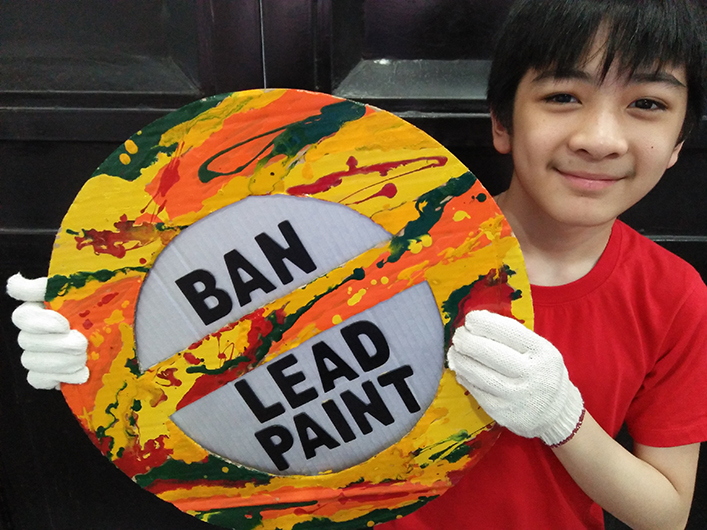More news
- Asian paint regulatory round up – Indonesian exterior paint still uses lead, warns W...
- Nigeria’s paint industry navigates regulatory changes and economic challenges amid p...
- Focus on the global coatings market: Global coatings market outlook
- Innovative coatings mitigate effects of deepening climate change
- Ask Joe Powder – October 2024

The historic ban on lead-containing paints in the Philippines was applauded in two events held in conjunction with the fifth session of the International Conference on Chemicals Management (ICCM5) in Bonn, Germany.
Convened in the context of the Strategic Approach to International Chemicals Management (or SAICM, a policy framework for global action on chemical hazards), ICCM5 aims to approve a new instrument for the sound management of chemicals and waste.
At the first side event held on September 26 on “Lead Paint Elimination: Its Significance for SAICM Progress and Implications for the New Framework,” government delegate Joel Maleon spoke about the country’s journey towards phasing out lead in paints, which was catalysed by the adoption in 2013 of a regulatory framework in the form of a Chemical Control Order (CCO) after due consultation with stakeholders. Maleon is Senior Environmental Management Specialist at the Department of Environment and Natural Resources – Environmental Management Bureau (DENR-EMB).

Caption: Government delegate Joel Maleon from DENR-EMB and NGO delegate Aileen Lucero from EcoWaste Coalition at ICCM5 in Bonn, Germany
READ MORE:
The EcoWaste Coalition urges Philippine government to uphold the ban and block lead paint imports
Mowilex Indonesia launches campaign to remove lead paint from store shelves for free
The CCO specified a 90 parts per million (ppm) total lead limit for all paints. It further established a phase-out period for lead-containing decorative paints (2013-2016) and industrial paints (2013-2019). In recognition of its positive socio-economic, health and environmental impacts, the CCO in 2021 received the prestigious Future Policy Award (special category on lead in paint). “While globally only a few countries have enacted comprehensive bans on the use of lead additives in all paints, the Philippines demonstrates that it is entirely possible to restrict the use of lead in all paints to the maximum limit of 90ppm, including in industrial paints, which generally have lead concentrations that are up to 10 times higher,” the World Future Council (WFC) noted.
At the second side event on September 27 on the theme “Driving Change: Empowering Communities to Advance SAICM Across the Planet,” NGO delegate Aileen Lucero shared how SAICM inspired the multi-stakeholders’ approach that saw the government, industry and the civil society dialoguing and collaborating to put an end to the use of lead additives in paint manufacturing. Lucero is the National Coordinator of the EcoWaste Coalition.
Lucero lauded the adoption of 90ppm total lead content limit for all types of paint as a regulatory approach that induced other policies on mandatory use of lead-safe paints in schools, social welfare facilities and publicly funded construction, renovation and maintenance activities, and the prohibition on the use of leaded paints on toys and other children’s products. She also underscored the commitment of the industry led by the Philippine Paint and Coatings Association (formerly called the Philippine Association of Paint Manufacturers) to transition to lead-safe paint formulations in accordance with the CCO.
READ MORE:
Toxic lead found in paint brushes used for food preparation in the Philippines
“There is still much work to be done in promoting strong compliance monitoring, particularly for paints manufactured by companies not affiliated with the paint industry association, and for paints imported from abroad,” she said. “We have yet to tackle lead paint legacy issues in a concerted manner, including creating further awareness on the hazards of lead dust when surfaces covered with lead paint are disturbed and the techniques to reduce such a serious threat to children’s health,” she added.
Both events were organised by the International Pollutants Elimination Network (IPEN), a network of more than 600 public interest NGOs in more than 120 countries that have come together to forge a healthier world where people and the environment are no longer harmed by the production, use and disposal of toxic chemicals.
With guidance and support from IPEN, the EcoWaste Coalition has generated useful data on lead in both decorative and industrial paints sold in the market, including online shopping sites, raised awareness among stakeholders about the toxicity of lead and the availability of alternatives, pushed for health-protective regulations and promoted the third-party Lead Safe Paint® certification programme.







